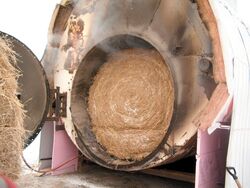
By Janis Schole, Contributing Editor
Bob Pickering of Foam Lake, Sask., built his own large capacity bale furnace that heats 40,000 sq. ft. at a fraction of the price of natural gas.
Pickering plans to burn 730 large round flax bales per year to heat two poultry barns. From the tim
e the furnace was completed in November, 2003, until late July, he had used about 400 bales.
"The barns have to be kept at about 95 degrees when we've got baby day-old chicks. Natural gas is still my backup, but it only kicks in if I'm out of straw or busy doing something else," he explains. "I plan to heat another 15,000 sq. ft. with it when I eventually run pipes to my shop and another smaller barn."Pickering says he was motivated to build the furnace because the cost of natural gas has been continually increasing.
"Two winters ago, we had a huge per month bill so we decided to do something about it," Pickering says. "After some research we came up with our own idea. We think we should have a payback in 2 1/2 years."
The furnace's firebox was made by inserting a 7-ft. dia. by 21-ft. long underground fuel tank into a larger 11-ft. dia. by 23-ft. long fuel tank so that the end of the smaller tank sticks out by about 3 in. The edges were sealed so that the space between the two tanks serves as a water jacket holding close to 10,000 gal.
"We put a door in the end of the smaller tank to insert the round bales," Pickering says. "The double-walled, 2 1/2-in. deep door has a sealed hole in it where we installed an old furnace fan with an adjustable damper on it. This is controlled by an aquastat. The door actually holds 50 to 60 gal. of water, making it part of the water jacket which keeps it from warping when the furnace is on a hot, fast burn. Water circulates through the door via a flexible radiator hose."
When water temperature in the main tank reaches the temperature pre-set on the aquastat, it will shut the fan off and the damper automatically closes, so the fuel bales smolder until heat is called for again.
They cut a hole at the back end of both tanks for a 16-ft. long by 10-in. dia. chimney made from 7/16-in. thick pipe. With the fan and chimney at opposite ends of the furnace, Pickering says the unit burns clean because of the air currents created.
"We welded a bunch of valves and bungs on the end of the water jacket and ran underground lines to our chicken barns. Each barn has a 14-gal. per min. pump that circulates hot water from the tank, through the barns and then back to the tank," he explains. "All we have in the barns are 1 1/4-in. copper lines with 4-in. aluminum fins. This makes a loop on the barn ceilings about an inch beneath our ceiling fans, using hangers we built out of flat iron. The fans push the heat down toward the floor."
For insurance purposes, Pickering says they had to locate the furnace about 100 ft. away from the barns. They poured a cement pad and built a metal stand to set the furnace on so it is out of the way.
He says he can load three 5 by 6-ft. round bales into the furnace at one time. On average throughout the year, he loads two bales per day - one in the morning and one in the evening.
"We've found that flax straw produces the fastest heat and the least amount of ash, but we have also burned wheat straw," he says. "Flax burns to dust and is a lot less work to clean. I clean the furnace once every six weeks using a scoop I built that attaches to the bale prong on my front-end loader. So far, I've just been spreading the ash around the furnace to keep the weeds down. It's like a heavy dose of phosphorus and would be too rich for anything to grow if you put it on your fields."
Pickering's bale furnace also serves a dual purpose -- as an incinerator for their dead birds and any burnable garbage.
"The biggest cost is putting the copper aluminum pipes (heating elements) in your barns. Everything else was made from salvage scrap that we picked up around the area," Pickering says. "Flax straw is readily available and most people find it hard to get rid of. People are offering it to me all the time for the cost of baling it. I expect to grow enough of my own this year, as I have about 700 acres in flax. It compares to coal in the amount of heat you get per ton."
